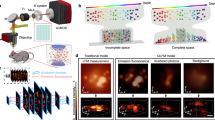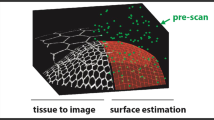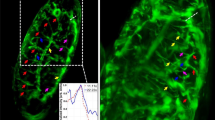Abstract
We report a technique for fluorescence tomography that operates beyond the penetration limits of tissue-sectioning fluorescence microscopy. The method uses multi-projection illumination and photon transport description in opaque tissues. We demonstrate whole-body three-dimensional visualization of the morphogenesis of GFP-expressing salivary glands and wing imaginal discs in living Drosophila melanogaster pupae in vivo and over time.
This is a preview of subscription content, access via your institution
Access options
Subscribe to this journal
Receive 12 print issues and online access
$259.00 per year
only $21.58 per issue
Buy this article
- Purchase on Springer Link
- Instant access to full article PDF
Prices may be subject to local taxes which are calculated during checkout



Similar content being viewed by others
References
Helmchen, F. & Denk, W. Nat. Methods 2, 932–940 (2005).
Yuste, R. Nat. Methods 2, 902–904 (2005).
Minsky, M. US patent 3,013,467 (1961).
Huang, D. et al. Science 254, 1178–1181 (1991).
Weissleder, R., Tung, C.H., Mahmood, U. & Bogdanov, A. Nat. Biotechnol. 17, 375–378 (1999).
Ntziachristos, V., Ripoll, J., Wang, L.H.V. & Weissleder, R. Nat. Biotechnol. 23, 313–320 (2005).
Arridge, S.R. Inverse Probl. 15, R41–R93 (1999).
Sharpe, J. et al. Science 296, 541–545 (2002).
Dodt, H.U. et al. Nat. Methods 4, 331–336 (2007).
Pomraning, G.C. Nucl. Sci. Eng. 127, 182–198 (1997).
Ward, R.E., Reid, P., Bashirullah, A., D'Avino, P.P. & Thummel, C.S. Dev. Biol. 256, 389–402 (2003).
Sun, B., Xu, P. & Salvaterra, P.M. Proc. Natl. Acad. Sci. USA 96, 10438–10443 (1999).
Ninov, N., Chiarelli, D.A. & Martin-Blanco, E. Development 134, 367–379 (2007).
Zeitlinger, J. & Bohmann, D. Development 126, 3947–3956 (1999).
Acknowledgements
We thank A. Soubret for his help and suggestions, and Polymicro Technologies LLC for providing us the fused silica capillary tubing. This work was supported by the US National Institutes of Health National Institute of Biomedical Imaging and BioEngineering grant RO1000750. C.P. is supported by an European Molecular Biology Organization fellowship. N.P. is a Howard Hughes Medical Institute investigator.
Author information
Authors and Affiliations
Contributions
C.V. and C.P. designed the experiment. C.V. developed the system, performed the experiments, developed the image processing and inversion schemes, analyzed data and wrote most of the paper. C.P. generated the GFP-expressing flies and performed histology and confocal microscopy. D.R. developed the inversion schemes, image reconstruction software and contributed to developing the photon propagation model. N.P. and V.N. supervised the project.
Corresponding author
Supplementary information
Supplementary Text and Figures
Supplementary Figures 1–3, Supplementary Methods (PDF 1281 kb)
Supplementary Video 1
Time evolution wing imaginal discs (0 degrees projection). Development of a D. melanogaster pupa expressing GFP in the wing imaginal discs at 0 degrees projection during 474 minutes. The red box in the bottom left part of the video indicates the relative time. (MOV 3490 kb)
Supplementary Video 2
Time evolution wing imaginal discs (90 degrees projection). Development of a D. melanogaster pupa expressing GFP in the wing imaginal discs at 90 degrees projection during 474 minutes. The red box in the bottom left part of the video indicates the relative time. (MOV 2828 kb)
Supplementary Video 3
Time evolution wing imaginal discs (180 degrees projection). Development of a D. melanogaster pupa expressing GFP in the wing imaginal discs at 180 degrees projection during 474 minutes. The red box in the bottom left part of the video indicates the relative time. (MOV 3255 kb)
Supplementary Video 4
Wing imaginal discs imaged at different projections. 6.5 hr D. melanogaster pupa expressing GFP in the imaginal discs; the movie corresponds to fluorescent projections detected by the CCD at different rotation angles. (MOV 2640 kb)
Supplementary Video 5
Head eversion. D. melanogaster pupa expressing GFP in the imaginal discs during the head eversion process (∼12 hrs APF). The images are acquired at one fixed projection. The red box in the bottom left part of the video indicates the relative time. (MOV 5892 kb)
Rights and permissions
About this article
Cite this article
Vinegoni, C., Pitsouli, C., Razansky, D. et al. In vivo imaging of Drosophila melanogaster pupae with mesoscopic fluorescence tomography. Nat Methods 5, 45–47 (2008). https://doi.org/10.1038/nmeth1149
Received:
Accepted:
Published:
Issue Date:
DOI: https://doi.org/10.1038/nmeth1149
This article is cited by
-
Applications, promises, and pitfalls of deep learning for fluorescence image reconstruction
Nature Methods (2019)
-
Optoacoustic mesoscopy for biomedicine
Nature Biomedical Engineering (2019)
-
Automated drosophila heartbeat counting based on image segmentation technique on optical coherence tomography
Scientific Reports (2019)
-
OptiJ: Open-source optical projection tomography of large organ samples
Scientific Reports (2019)
-
Phase-Retrieved Tomography enables Mesoscopic imaging of Opaque Tumor Spheroids
Scientific Reports (2017)



